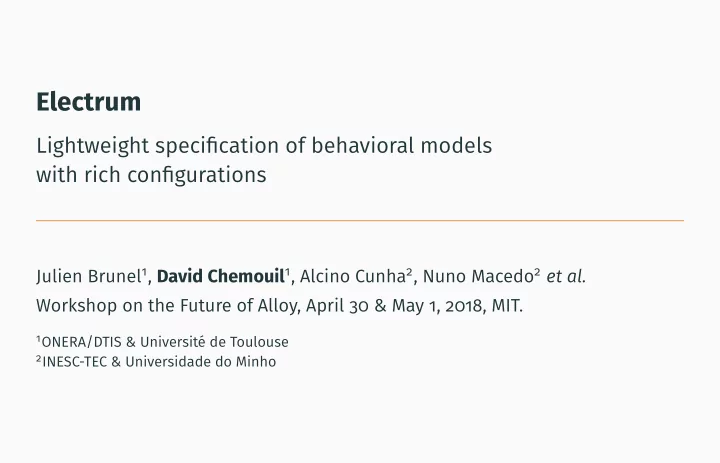

Electrum Lightweight specification of behavioral models with rich configurations Julien Brunel 1 , David Chemouil 1 , Alcino Cunha 2 , Nuno Macedo 2 et al. Workshop on the Future of Alloy, April 30 & May 1, 2018, MIT. 1 ONERA/DTIS & Université de Toulouse 2 INESC-TEC & Universidade do Minho
Observations Many Alloy models feature both structural and behavioral aspects, but: • Behavior modeling requires systematic “boilerplate” • explicit modeling of state (local/global state idiom) • every mutable construct must be indexed by state/time • specification of a linear model of time (most of the time (!)) • specific handling of the last state of a trace • Essentially to model check safety properties, indeed: • spurious counterexamples to liveness properties may happen, unless traces are enriched with lassos [Cunha 14, Biere et al. 99] • even then, limited to bounded model-checking (BMC) (Safety properties rule out unwanted behaviors, liveness properties characterize expected behaviors) 2/7
Remark Linear temporal logic (LTL): • is more expressive than propositional logic • is decidable • relies on a simple & uniform model of time: infinite traces of states • benefits from dedicated, complete model-checking procedures 3/7
Introducing Electrum Mark mutable fields or signatures as such (using a new var keyword). Add LTL + primed variables (as, e.g. , in TLA+). Dedicated analyses: • BMC by reduction to Alloy + traces with lassos • Unbounded MC (UMC) by reduction to NuSMV or nuXmv SAT Solvers SAT Electrum Analyzer Pardinus SAT Alloy Analyzer Kodkod SMV Model Electrod SAT Checkers SAT 4/7
Example: Chord sig Node { var fst : lone Node, pred join [new : Node] { // an event var snd : lone Node, new not in members var prdc : lone Node, some m : members { var todo : Status → Node } between[m, new, m � fst] fst’ = fst + + new → m � fst var sig members in Node {} snd’ = snd + + new → m � snd prdc’ = prdc + + new → m var sig ringMembers in members {} todo’ = todo }} fact { fact strongFairness { always members = all n, m : Node { { n: Node | some n � fst and ( always eventually rectifyEnabled[n,m]) some n � snd and ⇒ ( always eventually rectify[n,m]) some n � prdc } . . . }} always ringMembers = { m : members | m in m � ^succ }} assert correctness { ( eventually always not (join or fail) fun succ : Node → lone Node { . . . } implies eventually always ideal ) } 5/7 . . .
Assessment Fits well most Alloy models with behavior . Often leaner than plain Alloy (not always: e.g. counting events). BMC efficiency on par with classic Alloy. UMC with nuXmv comparable to TLA+’s TLC (room for improvement) (note: nuXmv is not free software; other, non-evaluated, tools exist). Modeling [Zave 2017]’s version of Chord raised various corner cases: analyzing “abstract” liveness properties if useful (even with BMC). 6/7
Prospect Enhance modeling of the “system” (automaton) part, e.g. : actions (guard + post-condition), frame rules, fairness constraints... Most models may then rely on LTL for assertions only. So add branching time (CTL) too? No more a conservative extension of Alloy, though. 7/7
Recommend
More recommend